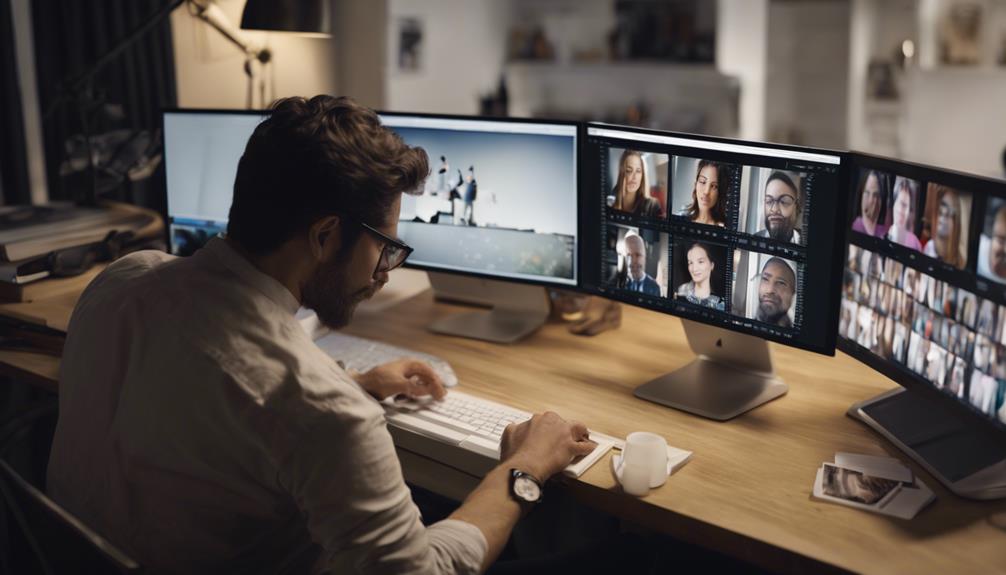Are you struggling to balance your photography workload and administrative tasks? Delegating photography tasks to a virtual assistant can be a game-changer for your productivity. By entrusting certain responsibilities to a skilled assistant, you can focus on capturing those perfect shots and growing your business. But how do you effectively delegate these tasks to ensure top-notch results? Let’s explore some key strategies that will help you streamline your workflow and elevate your photography business to new heights.
Identifying Tasks to Delegate
Identify the specific photography tasks that you can effectively delegate to a virtual assistant to streamline your workflow and increase productivity. When it comes to equipment management, a virtual assistant can handle inventory tracking, equipment maintenance schedules, and even ordering supplies when needed. This frees up your time to focus on the creative aspects of your work.
For editing techniques, consider delegating tasks such as color correction, cropping, and exposure adjustments. A skilled virtual assistant can follow your style guide to ensure consistency across your portfolio. Image selection is another task that can be outsourced. Your assistant can sift through large batches of photos, flagging the best shots for your final review.
Lastly, photo retouching is a time-consuming yet crucial task that can be delegated. From blemish removal to skin smoothing, a virtual assistant with expertise in photo editing software can enhance your images while you concentrate on shooting. By entrusting these tasks to a virtual assistant, you can focus on what you do best while ensuring a more efficient workflow.
Prioritizing Tasks Effectively
To optimize your workflow and maximize productivity, categorize photography tasks based on urgency and impact to effectively prioritize them for delegation to a virtual assistant. Proper time management and task organization are essential in ensuring that your photography projects are completed efficiently. Here are some key points to consider when prioritizing tasks:
- Urgency: Identify tasks that have strict deadlines or are time-sensitive to ensure they are completed on time.
- Impact: Consider the significance of each task in relation to your overall photography goals to prioritize those that will have the most significant impact.
- Complexity: Evaluate the complexity of each task and prioritize simpler ones that can be quickly delegated to free up time for more intricate projects.
- Client Needs: Prioritize tasks that directly impact client satisfaction or are crucial for meeting client requirements to maintain a high level of service.
Providing Clear Instructions and Guidelines
When assigning tasks to a virtual assistant for photography work, ensure you provide clear task objectives to avoid any confusion. Detailed guidelines should be given to guide the assistant on how to accomplish the tasks effectively. Set communication expectations early on to maintain a smooth workflow throughout the delegation process.
Clear Task Objectives
Establishing precise and comprehensive task objectives is essential when delegating photography tasks to a virtual assistant. Clear communication regarding what needs to be achieved will help ensure that the final outcome meets your expectations. To effectively convey your task objectives, consider the following:
- Task Clarity: Clearly define the specific photography tasks you want the virtual assistant to undertake. Whether it’s editing images, organizing files, or setting up a photoshoot, provide clear instructions on what is expected.
- Objective Alignment: Align the task objectives with your overall goals and vision for the project. Ensure that the virtual assistant understands the purpose behind each task to maintain cohesiveness in the work they produce.
- Communication: Regularly communicate with the virtual assistant to clarify any doubts or provide additional guidance. Encourage open dialogue to address any issues promptly and ensure that the tasks are progressing as intended.
- Feedback Loop: Establish a feedback loop to review the work done by the virtual assistant. Provide constructive feedback to help them improve and align their future tasks with your preferences.
Detailed Guidelines Provided
Provide detailed guidelines and instructions to your virtual assistant to ensure clarity and precision in task execution. When delegating photography tasks, time management is crucial. Clearly outline deadlines for each task to help your virtual assistant prioritize effectively. Additionally, provide a breakdown of the steps involved in completing the assignment to assist in time allocation and task sequencing.
To foster skill development in your virtual assistant, offer detailed guidelines that not only outline the task requirements but also explain the reasoning behind them. This approach helps your assistant understand the purpose behind each task, facilitating skill acquisition and improvement over time. Encourage your virtual assistant to ask questions and seek clarification on any aspects of the guidelines that may be unclear.
Communication Expectations Set
Set clear expectations for communication by ensuring that your instructions and guidelines are concise and detailed. When delegating photography tasks to a virtual assistant, effective communication is crucial for successful outcomes. Here are some key points to consider:
- Communication Styles: Clearly outline your preferred communication methods, whether it’s through email, messaging apps, or video calls. Establish how often you expect updates and progress reports to maintain transparency.
- Feedback Methods: Provide specific guidelines on how you want feedback delivered. Whether it’s constructive criticism or praise, make sure your virtual assistant understands how to communicate their findings effectively.
- Remote Work Challenges: Acknowledge the challenges of working remotely and address any potential communication barriers upfront. Encourage open dialogue and offer support to overcome any obstacles that may arise.
- Team Dynamics: Foster a sense of teamwork and collaboration by setting clear expectations on how you envision the virtual assistant fitting into the larger team. Encourage communication between team members to ensure a cohesive workflow.
Setting Realistic Deadlines
To ensure efficient workflow and successful completion of tasks, it is crucial to establish clear and achievable deadlines when delegating photography tasks to a virtual assistant. Effective time management is key in this process. When setting deadlines, consider the complexity of the task and the skill level of the assistant. Be realistic in your expectations, allowing enough time for the virtual assistant to produce high-quality work without feeling rushed. By clearly outlining task expectations and deadlines, you provide a roadmap for the assistant to follow, minimizing confusion and maximizing productivity.
When establishing deadlines, communicate any specific requirements or preferences you have regarding the project. This ensures that the assistant understands the task fully and can deliver results that align with your vision. Remember, setting realistic deadlines is not only beneficial for the assistant but also for you as the delegator, as it helps you track progress and manage multiple projects effectively. By prioritizing time management and task expectations, you set the stage for a successful collaboration with your virtual assistant.
Establishing Efficient Communication Channels
When delegating photography tasks to a virtual assistant, ensure efficient communication channels are established to facilitate seamless collaboration and project management. Effective communication is key to the success of remote team collaboration. Here are four essential tips to establish efficient communication channels with your virtual assistant:
- Virtual Assistant Training: Provide your virtual assistant with clear guidelines on communication protocols, preferred methods of contact, and response times. This training will help them understand your expectations and streamline communication processes.
- Utilize Project Management Tools: Consider using project management tools like Trello, Asana, or Slack to assign tasks, set deadlines, and communicate project updates in real-time. These tools enhance visibility and transparency within your remote team.
- Regular Check-ins: Schedule regular check-in meetings via video conferencing to discuss ongoing projects, address any issues, and provide feedback. These meetings help maintain a sense of connection and accountability within the team.
- Establish Clear Communication Channels: Clearly define which communication channels should be used for different types of communication, such as emails for formal instructions and instant messaging for quick queries. This clarity avoids confusion and ensures efficient communication flow.
Monitoring Progress and Providing Feedback
As you oversee tasks delegated to your virtual assistant, remember to track task milestones to ensure progress aligns with your expectations. Providing constructive criticism is essential for improvement, but remember to balance it with positive feedback. Encourage open communication channels to address any concerns promptly and maintain a collaborative working relationship.
Track Task Milestones
Keep a close eye on the progress of your delegated photography tasks by regularly checking in on task milestones and offering constructive feedback. Progress tracking and milestone monitoring are crucial aspects of ensuring that your virtual assistant is on the right track. Here are four key strategies to effectively track task milestones:
- Set Clear Milestones: Define specific and measurable milestones for each photography task to provide a clear roadmap for your virtual assistant to follow.
- Utilize Project Management Tools: Implement project management tools like Trello, Asana, or Monday.com to track task progress, deadlines, and overall project status efficiently.
- Regular Check-Ins: Schedule regular check-in meetings or calls to discuss the progress of delegated tasks, address any challenges, and provide feedback promptly.
- Celebrate Achievements: Acknowledge and celebrate milestones reached by your virtual assistant to boost morale and motivation, fostering a positive working relationship.
Offer Constructive Criticism
Regularly providing constructive criticism to your virtual assistant based on monitored progress is essential for optimizing task outcomes and fostering professional growth. When offering feedback, consider employing various techniques to ensure it is constructive and beneficial. Start by highlighting what was done well before delving into areas that could be improved. Encourage open communication by framing critiques as opportunities for growth rather than pointing out mistakes.
When critiquing a photography task, focus not only on technical aspects but also on artistic vision. Provide feedback on composition, lighting, and editing techniques while also allowing room for your assistant’s creative input. Acknowledge their unique perspective and encourage them to experiment with new ideas to enhance the overall quality of the work.
Encourage Open Communication
Encouraging open communication with your virtual assistant is crucial for effectively monitoring progress and providing constructive feedback on photography tasks. Establishing a feedback culture and fostering team collaboration are essential elements in remote work with virtual teams. Here are four key strategies to encourage open communication:
- Regular Check-Ins: Schedule frequent virtual meetings or check-ins with your virtual assistant to discuss ongoing projects, address any challenges, and provide real-time feedback.
- Utilize Communication Tools: Make use of various communication platforms like Slack, Zoom, or Microsoft Teams to facilitate quick and efficient exchanges of information and feedback.
- Encourage Questions: Create a safe space where your virtual assistant feels comfortable asking questions, seeking clarification, and discussing any concerns that may arise during the photography tasks.
- Constructive Criticism: Offer feedback in a constructive manner, focusing on specific areas for improvement while also acknowledging achievements to maintain motivation and enhance performance.
Frequently Asked Questions
How Can I Ensure My Virtual Assistant Maintains Confidentiality With My Photos?
To ensure confidentiality assurance with your photos, implement photo watermarking. This technique adds a layer of protection by embedding visible or invisible marks into your images. It helps track unauthorized use and maintains the privacy of your content.
What Software or Tools Should I Provide for the Virtual Assistant?
Seek secure file sharing solutions like Dropbox for seamless collaboration. Ensure editing software aligns with your requirements; Adobe Creative Cloud or Lightroom can enhance productivity. Prioritize protection and precision in delegating photography tasks effectively.
Can I Request Specific Editing Styles or Must I Trust the Va’s Judgment?
When it comes to editing preferences, clear communication is key. Trust your VA’s judgment but provide guidance on preferred styles. Offer training, give constructive feedback, and establish open dialogue for a collaborative approach in achieving the desired results.
How Do I Handle Timezone Differences When Setting Deadlines?
When juggling timezone coordination for deadlines with a Virtual Assistant, leverage tools like World Time Buddy for time zone conversions. Set clear communication strategies and establish productivity hacks like using shared calendars to stay organized and efficient.
What Should I Do if I Am Not Satisfied With the Quality of Work?
If you’re not satisfied with the work, ensure a robust quality assurance process. Give clear, constructive feedback. Collaborate on improvements. Strengthen communication for better outcomes. Your guidance can help refine the work to meet your standards.



